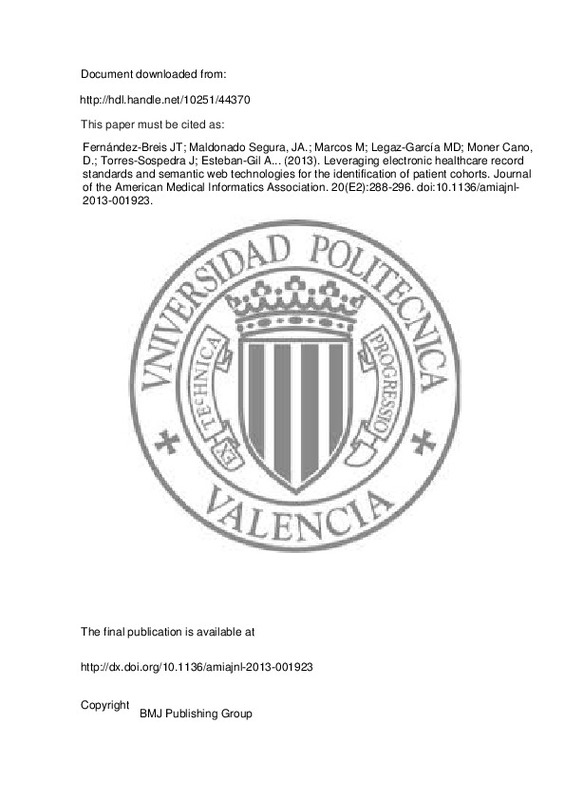Cuggia, M., Besana, P., & Glasspool, D. (2011). Comparing semi-automatic systems for recruitment of patients to clinical trials. International Journal of Medical Informatics, 80(6), 371-388. doi:10.1016/j.ijmedinf.2011.02.003
Sujansky, W. (2001). Heterogeneous Database Integration in Biomedicine. Journal of Biomedical Informatics, 34(4), 285-298. doi:10.1006/jbin.2001.1024
Schadow G Russler DC Mead CN . Integrating medical information and knowledge in the HL7 RIM. Proceedings of the AMIA Symposium, 2000:764–8.
[+]
Cuggia, M., Besana, P., & Glasspool, D. (2011). Comparing semi-automatic systems for recruitment of patients to clinical trials. International Journal of Medical Informatics, 80(6), 371-388. doi:10.1016/j.ijmedinf.2011.02.003
Sujansky, W. (2001). Heterogeneous Database Integration in Biomedicine. Journal of Biomedical Informatics, 34(4), 285-298. doi:10.1006/jbin.2001.1024
Schadow G Russler DC Mead CN . Integrating medical information and knowledge in the HL7 RIM. Proceedings of the AMIA Symposium, 2000:764–8.
Johnson PD Tu SW Musen MA . A virtual medical record for guideline-based decision support. Proceedings of the AMIA 2001 Annual Symposium, 294–8.
German, E., Leibowitz, A., & Shahar, Y. (2009). An architecture for linking medical decision-support applications to clinical databases and its evaluation. Journal of Biomedical Informatics, 42(2), 203-218. doi:10.1016/j.jbi.2008.10.007
Peleg, M., Keren, S., & Denekamp, Y. (2008). Mapping computerized clinical guidelines to electronic medical records: Knowledge-data ontological mapper (KDOM). Journal of Biomedical Informatics, 41(1), 180-201. doi:10.1016/j.jbi.2007.05.003
Maldonado, J. A., Costa, C. M., Moner, D., Menárguez-Tortosa, M., Boscá, D., Miñarro Giménez, J. A., … Robles, M. (2012). Using the ResearchEHR platform to facilitate the practical application of the EHR standards. Journal of Biomedical Informatics, 45(4), 746-762. doi:10.1016/j.jbi.2011.11.004
Parker CG Rocha RA Campbell JR . Detailed clinical models for sharable, executable guidelines. Stud Health Technol Inform 2004;107:145–8.
Clinical Information Modeling Initiative. http://informatics.mayo.edu/CIMI/index.php/Main_Page (accessed Jun 2013).
W3C, OWL2 Web Ontology Language. http://www.w3.org/TR/owl2-overview/ (accessed Jun 2013).
European Commission. Semantic interoperability for better health and safer healthcare. Deployment and research roadmap for Europe. ISBN-13: 978-92-79-11139-6, 2009.
SemanticHealthNet. http://www.semantichealthnet.eu/ (accessed Jun 2013).
Martínez-Costa, C., Menárguez-Tortosa, M., Fernández-Breis, J. T., & Maldonado, J. A. (2009). A model-driven approach for representing clinical archetypes for Semantic Web environments. Journal of Biomedical Informatics, 42(1), 150-164. doi:10.1016/j.jbi.2008.05.005
Iqbal AM . An OWL-DL ontology for the HL7 reference information model. Toward useful services for elderly and people with disabilities Berlin: Springer, 2011:168–75.
Tao, C., Jiang, G., Oniki, T. A., Freimuth, R. R., Zhu, Q., Sharma, D., … Chute, C. G. (2012). A semantic-web oriented representation of the clinical element model for secondary use of electronic health records data. Journal of the American Medical Informatics Association, 20(3), 554-562. doi:10.1136/amiajnl-2012-001326
Heymans, S., McKennirey, M., & Phillips, J. (2011). Semantic validation of the use of SNOMED CT in HL7 clinical documents. Journal of Biomedical Semantics, 2(1), 2. doi:10.1186/2041-1480-2-2
Menárguez-Tortosa, M., & Fernández-Breis, J. T. (2013). OWL-based reasoning methods for validating archetypes. Journal of Biomedical Informatics, 46(2), 304-317. doi:10.1016/j.jbi.2012.11.009
Lezcano, L., Sicilia, M.-A., & Rodríguez-Solano, C. (2011). Integrating reasoning and clinical archetypes using OWL ontologies and SWRL rules. Journal of Biomedical Informatics, 44(2), 343-353. doi:10.1016/j.jbi.2010.11.005
Tao C Wongsuphasawat K Clark K . Towards event sequence representation, reasoning and visualization for EHR data. Proceedings of the 2nd ACM SIGHIT International Health Informatics Symposium (IHI'12). New York, NY, USA: ACM:801–6.
Bodenreider O . Biomedical ontologies in action: role in knowledge management, data integration and decision support. IMIA Yearbook of Medical Informatics 2008;67–79.
Beale T . Archetypes. Constraint-based domain models for future-proof information systems. http://www.openehr.org/files/publications/archetypes/archetypes_beale_web_2000.pdf
SNOMED-CT. http://www.ihtsdo.org/snomed-ct/ (accessed Jun 2013).
UMLS Terminology Services. https://uts.nlm.nih.gov/home.html (accessed Jun 2013).
The openEHR Foundation, openEHR Clinical Knowledge Manager. http://www.openehr.org/knowledge/ (accessed Jun 2013).
Maldonado, J. A., Moner, D., Boscá, D., Fernández-Breis, J. T., Angulo, C., & Robles, M. (2009). LinkEHR-Ed: A multi-reference model archetype editor based on formal semantics. International Journal of Medical Informatics, 78(8), 559-570. doi:10.1016/j.ijmedinf.2009.03.006
SAXON XSLT and XQuery processor. http://saxon.sourceforge.net/ (accessed Jun 2013).
NCBO Bioportal. http://bioportal.bioontology.org/ (accessed Jun 2013).
The Protégé Ontology Editor and Knowledge Acquisition System. http://protege.stanford.edu/ (accessed Jun 2013).
Semantic Web Integration Tool. http://sele.inf.um.es/swit (accessed Jun 2013).
Hermit Reasoner. http://www.hermit-reasoner.com/ (accessed Jun 2013).
The OWLAPI. http://owlapi.sourceforge.net/ (accessed Jun 2013).
Institute for Health Metrics and Evaluation. Global Burden of Disease. http://www.healthmetricsandevaluation.org/gbd (accessed Jun 2013).
Segnan N Patnick J von Karsa L . European guidelines for quality assurance in colorectal cancer screening and diagnosis 2010. First Edition. European Union. ISBN 978-92-79-16435-4.
W3C. XQuery 1.0: An XML Query Language. http://www.w3.org/TR/xquery/ (accessed Jun 2013).
DL Query. http://protegewiki.stanford.edu/wiki/DL_Query (accessed Jun 2013).
SPARQL Query Language for RDF. http://www.w3.org/TR/rdf-sparql-query/ (accessed Jun 2013).
Semantic Web Rule Language. http://www.w3.org/Submission/SWRL/ (accessed Jun 2013).
Marcos, M., Maldonado, J. A., Martínez-Salvador, B., Boscá, D., & Robles, M. (2013). Interoperability of clinical decision-support systems and electronic health records using archetypes: A case study in clinical trial eligibility. Journal of Biomedical Informatics, 46(4), 676-689. doi:10.1016/j.jbi.2013.05.004
Marcos, M., Maldonado, J. A., Martínez-Salvador, B., Moner, D., Boscá, D., & Robles, M. (2011). An Archetype-Based Solution for the Interoperability of Computerised Guidelines and Electronic Health Records. Lecture Notes in Computer Science, 276-285. doi:10.1007/978-3-642-22218-4_35
MobiGuide: Guiding patients anytime everywhere. http://www.mobiguide-project.eu/ (accessed Jun 2013).
EURECA: Enabling information re-Use by linking clinical RE search and Care. http://eurecaproject.eu/ (accessed Jun 2013).
Rea, S., Pathak, J., Savova, G., Oniki, T. A., Westberg, L., Beebe, C. E., … Chute, C. G. (2012). Building a robust, scalable and standards-driven infrastructure for secondary use of EHR data: The SHARPn project. Journal of Biomedical Informatics, 45(4), 763-771. doi:10.1016/j.jbi.2012.01.009
Clinical Element Models. http://informatics.mayo.edu/sharp/index.php/CEMS (accessed Jun 2013).
[-]







![[Cerrado]](/themes/UPV/images/candado.png)


